Menu
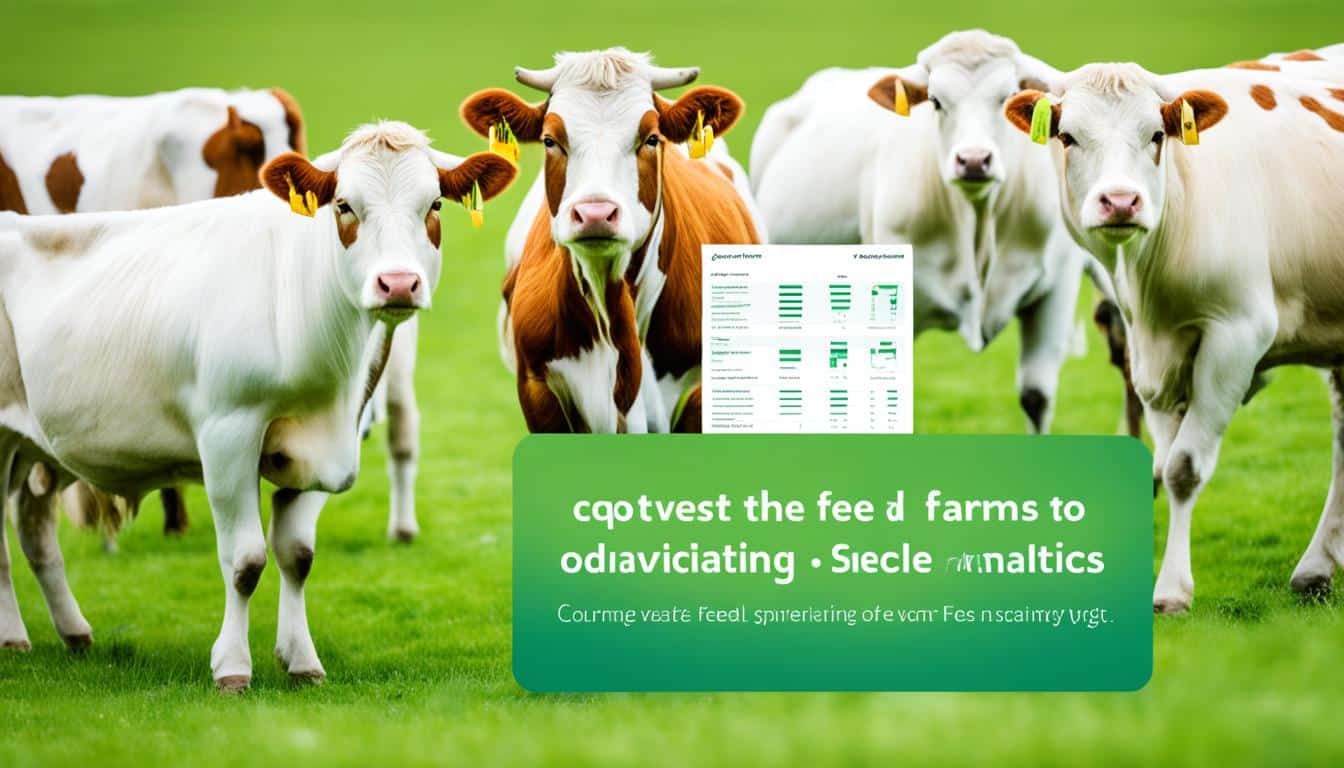
Did you know precision agriculture is widely researched for its benefits in farming? It’s a game-changer, especially when it comes to livestock health analytics. With its help, farmers can boost both their output and profits. For instance, spotting diseases early, like mastitis, can cut down on antibiotics. This not only helps the planet but also makes farm work more profitable.
Tools such as HIPRA Stats turn data into smarter farming choices, which means more efficient farms. They work even better when linked with services like Microsoft Azure. This kind of technology makes it possible to raise healthier animals in more places. So, we see that tech is really changing the game in farming.
Livestock health analytics is changing how we care for animals and improve their health. It’s a key part of a farming approach called precision livestock farming. This helps farms be more sustainable and make more money. With *animal health monitoring*, farmers can spot health problems early. This means they can act fast to keep their animals healthy.
Farming today is fast and needs to be smart. *Livestock management tools* are essential. They make animals healthier and boost the farm’s output. These tools collect health data to see patterns and unusual signs. This helps farmers make better choices. The world’s growing desire for beef shows how important efficient farming is. Technology like health analytics is key to meet this demand.
Livestock health analytics uses data analysis and health checks to run farms better. It turns data into advice that improves animal health and farm success. By using *animal health monitoring* with PLF, farms can be more proactive. They can take steps before issues become big problems, making everything on the farm run smoother.
“For modern farming, livestock health analytics is more than a technological advancement; it is a necessity that ensures the sustainable growth and productivity of our livestock sectors.”
| Aspect | Benefit |
|---|---|
| Animal Health Monitoring | Early disease detection, improved welfare |
| Livestock Management Tools | Enhanced productivity, reduced costs |
| Optimising Livestock Production | Sustainable growth, higher profitability |
Using data analysis has made farming much better. It boosts productivity and cuts costs while making sure the animals are looked after well. The latest tech tools give farmers an edge, helping them make smarter choices and farm in ways that are good for the planet.
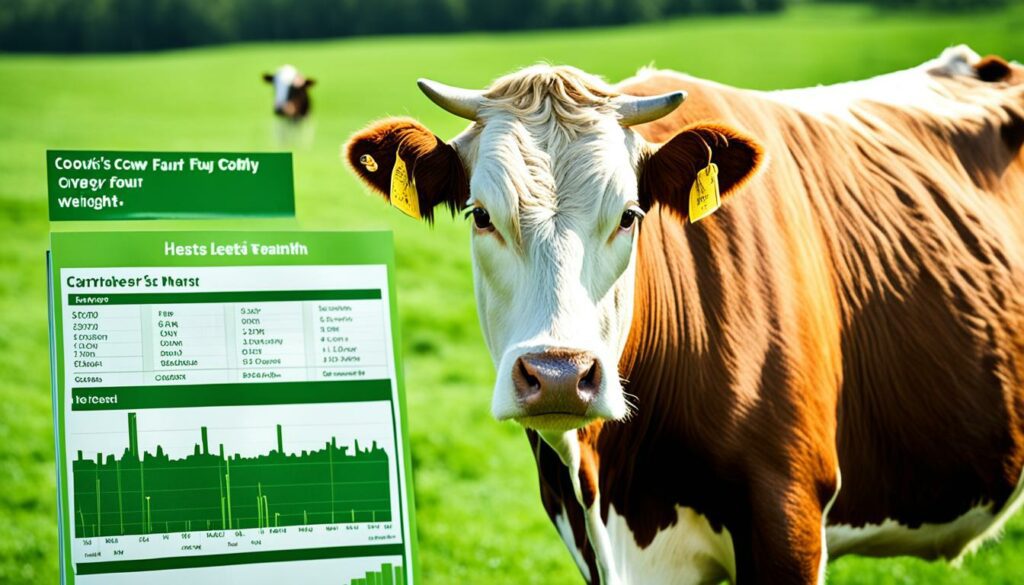
Data analysis has boosted how well farms work. Farmers can now make quick decisions based on real-time data. This data tells them everything about their animals – how healthy they are, where they are, what they’re doing, and what they’re eating. This means farmers can step in quickly and keep their animals in top shape, which makes them more productive.
Looking at data helps cut the money spent on running the farm. It does this by making farm management smarter and needing fewer antibiotics. The tech keeps an eye on each animal, helping stop diseases from spreading. This detailed data also makes planning and using resources more efficient, which saves money.
Working with data also makes sure the animals are doing well. Farmers can watch each animal closely, spotting any signs of trouble fast. This early warning helps keep diseases like mastitis from spreading. It also means farmers can act quickly to help their animals when they need it, keeping them healthy and happy.
| Benefit | Description |
|---|---|
| Improved Productivity | Real-time monitoring and decision-making, detailed performance insights, timely interventions |
| Cost Reduction | Optimisation of management practices, reduced reliance on antibiotics, enhanced biosecurity |
| Enhanced Animal Welfare | Close monitoring of health metrics, early disease detection, better livestock wellbeing |
It’s vital to use the right tools for keeping livestock healthy. Wearable sensors, data collection, and health software work together. They help us track and understand important health information.
Devices like neck accelerometers and jaw pressure sensors are key. They monitor how livestock are doing, giving immediate health feedback. Technologies like GPS and accelerometers help spot signs of ill health fast. This means we can act quickly to help sick animals.
Gathering health data is crucial. Sensors send data, which is then analysed by computers to give deep health insights. Storing this data online makes it easy to use and share. This supports smarter choices about livestock well-being.
Software such as HIPRA Stats is a must for looking after livestock. It takes data from sensors to show health trends. For example, smart collars use AI to watch over animals, alerting farmers to issues fast. These high-tech solutions really improve farm work and care for animals.
To get the most from these tools, a good plan is needed. Choosing the right devices and fitting them into your farm system is critical. This planning is the key to success in tracking livestock performance and health.
| Technology | Function | Benefits |
|---|---|---|
| Wearable Sensors | Track livestock movement and behaviour | Real-time health analysis, early illness detection |
| Data Collection Systems | Gather and store health metrics | Enhanced decision-making, seamless data access |
| Health Monitoring Software | Process and analyse collected data | Actionable insights, improved farm productivity |
The use of livestock health analytics boosts modern farm work greatly. Farmers start by setting up and investing wisely in the needed tech. Then, they connect these new systems with their current ways of managing the farm. Training is key. It helps farmers learn how to use these new tools well. This way, they get the most out of farming with data.
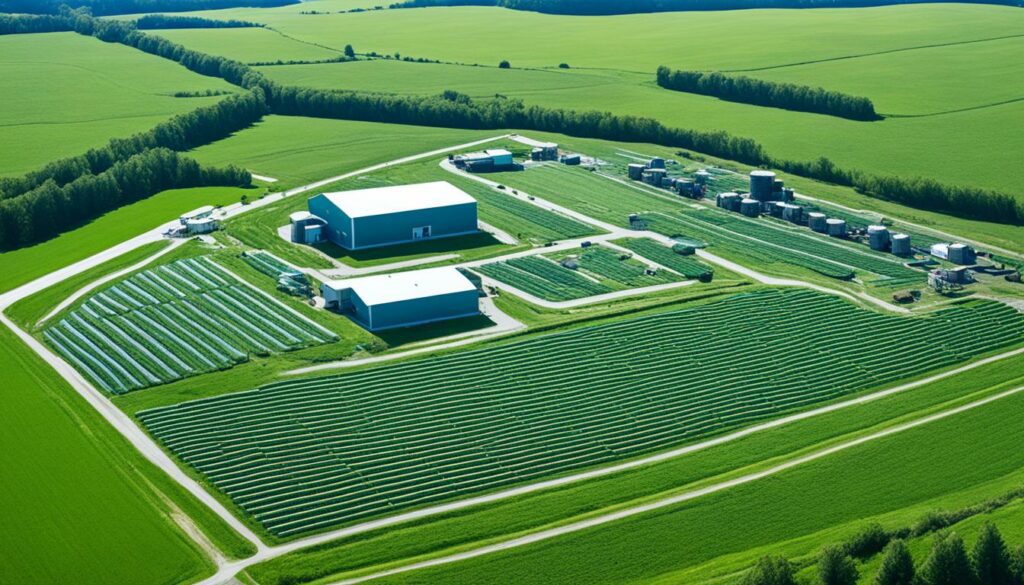
Getting into livestock health analytics starts with a thorough setup. This means looking at what the farm already has and what’s missing. To do this, farmers may have to spend a lot on tech like sensors, data systems, and storage. A good example is Zoetis’ CLARIFIDE Plus. It spots dairy cows that might get mastitis. This keeps the whole herd healthier, boosting milk making which hit 881 million tonnes in 2019.
It’s key to smoothly connect new livestock tools with the farm’s existing ones. This is where mixing old farming ways with new tech is important. Zoetis’ use of AI and Machine Learning can help. A tool like the Mastitis Risk Prediction Algorithm warns farmers about sick animals earlier. This cuts loss and keeps up high productivity. Scotland saw lower emissions by 4.5% due to better disease control in beef cattle because of using advanced tools.
For these new farm strategies to work, farmers need solid training and support. They should have access to courses that teach them how to use the latest tools. It’s vital for them to learn how to read and act on the health data they get. For instance, changing what Angus heifers eat can cut methane by up to 33%. This shows how crucial smart choices are. Also, tools like Zoetis’ CLARIFIDE Plus is in more than 40 places. This means lots of farmers can get help worldwide.
In the world of modern farming, real-time health monitoring is key to looking after animals well and keeping them productive. With wearable sensors and the latest tech, farmers can now deeply analyse their animals’ behaviour. This helps spot signs of illness early.
Sensors are crucial in keeping an eye on animals’ health around the clock. They’re put on the animals and they track things like how they move, what they eat, and their temperature. All this info is sent and looked at. It gives a full picture of each animal’s health. This speeds up making good choices for them.
Real-time health monitoring is amazing at watching animals closely. It checks their daily habits to pick up on hidden signs of health problems. Like, if an animal eats or moves differently, it could mean it’s getting sick. Catching these changes early helps prevent serious health issues.
There are many great achievements with real-time health tracking. For instance, using powerful tech like YOLOv5 and YOLOv7-E6E to track how animals act. These tools are great at spotting when animals aren’t acting normally. They help farmers catch health problems early, making it easier to help the animals.
Improving how efficiently we manage livestock farms is key in today’s world. With data analysis, farmers get important info to boost their work. Tracking the performance of their animals closely is crucial; it involves watching many factors closely.
Tracking performances starts with keeping a close eye on how animals grow. This means recording things like how much they weigh, what they eat, and how healthy they are. By using tools like sensors and weighing machines, farmers can get updates in real time. This helps them make sure the animals are growing just right.
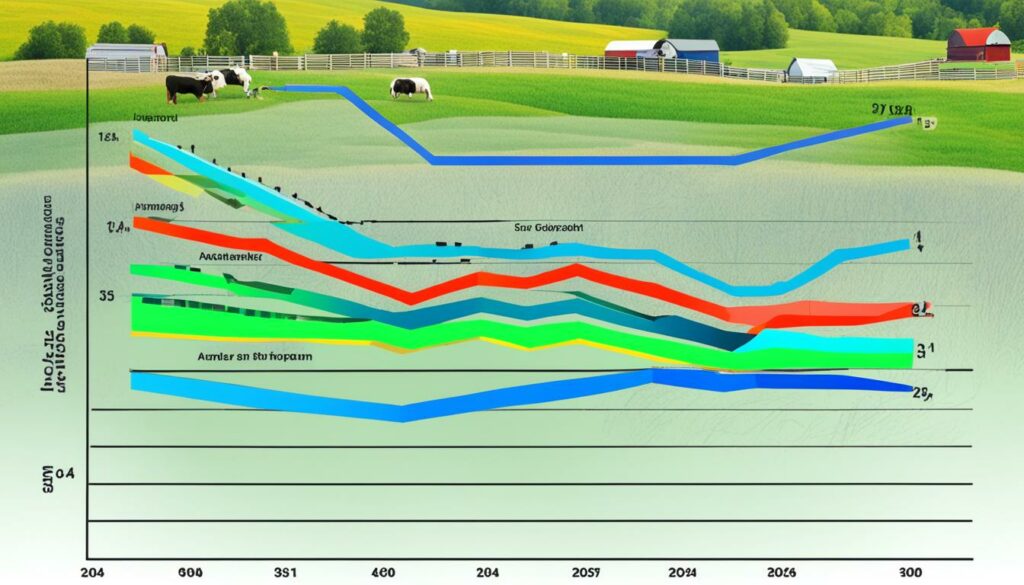
Getting animal feed and nutrition right is also very important. Real-time data about eating and how it affects the animals lets farmers tweak things as needed. With tech like AI and many kinds of gadgets, they can study how animals eat and their health. This allows them to use food better.
| Aspect | Traditional Method | AI-Enhanced Method |
|---|---|---|
| Feed Monitoring | Manual Recording | Automated Sensors |
| Health Check | Periodic Vet Visits | Continuous Real-Time Monitoring |
| Data Analysis | Basic Spreadsheets | Advanced Machine Learning Algorithms |
| Decision Making | Experience-Based | Data-Driven Insights |
In all, using data analysis and modern tracking tech can greatly improve how farms run. This helps in managing animal health and growth well, and in making feed use efficient. These changes are good for farm work and for making farming more sustainable.
Detecting and preventing diseases in livestock is vital for farms to stay productive and sustainable. With tools like somatic cell counts, farmers can spot and deal with diseases quickly. This helps in using tech to prevent illnesses effectively.
Livestock diseases hurt the economy, especially in milk farms. For example, if foot-and-mouth disease spreads, milk farms may produce less. Issues like claw problems in cows affect milk, baby cows, and how long they can work. Finding these problems early through technology lets farmers lower their losses.
Analytics are key in stopping livestock diseases. They use health tech to give useful data for preventing sickness. Quick alerts from these tools help keep diseases like foot problems and hidden sicknesses low. These strategies help make farms safer and reduce the need for medicines.
Good livestock management needs constant tracking and analysing of health data. By watching key health measures, farms can do better. They can improve the health of their animals and make their farms more productive.
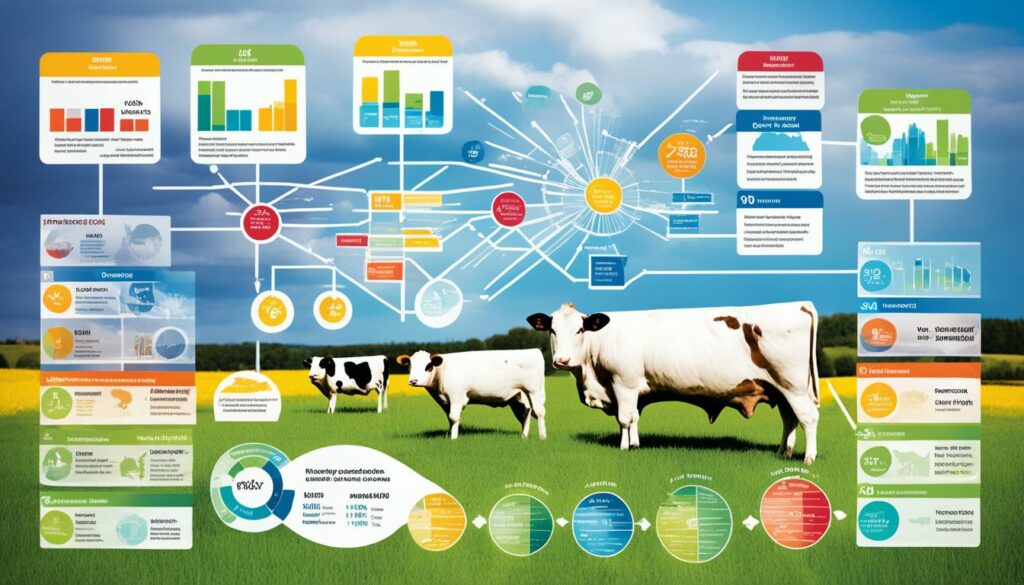
Some health signs are very important, like mastitis in dairy cows. In the U.S., it hits one in four cows, lowering milk and costing $2 billion a year. So, it’s crucial to watch for mastitis outbreaks.
Other key signs to note are growth and what the animals eat. Always keeping track helps a farmer know their animals’ health and react quickly to problems. Data like how much milk or meat the farm makes are useful clues.
Detailed data analysis can make farm decisions smarter. Tools like Zoetis’ CLARIFIDE Plus help by giving insight into the animals’ genes. This helps with better breeding and taking good care of the animals.
There are also learning events, like one in Ethiopia in April 2024. They help see how to use data for better decisions. Knowing these things helps farmers to plan and use their resources better.
| Health Metric | Impact | Annual Cost or Gain |
|---|---|---|
| Mastitis Incidence | Increased treatment and reduced milk productivity | $2 billion (Lost milk production and treatment costs) |
| Milk Production | Overall productivity measure | 881 million tons (2019) |
| Meat Production | Indicator of beef cattle health and efficiency | 58 metric tons (2014-2023) |
In the end, using health metrics helps make farm decisions better. It leads to healthier animals, more productivity, and farm plans that meet their goals well.
Livestock health analytics are changing how farms work, from big enterprises to small ones. They help improve both the amount of goods produced and how well the animals are taken care of. This is a big win for farming everywhere, showing the power of using data to make decisions.
In 2009, the Food and Agriculture Organization (FAO) found that tracking how healthy animals are has big benefits. It led to happier animals and better farms. This ties in well with the FAO’s goal to show that looking after animals well means more goods from the farm.
The World Bank’s 2019 report shared that managing animals better in Africa’s rural places cut down on poverty. This was because it meant the animals produced more.
Here’s a quick look at the numbers:
| Study | Findings | Impact |
|---|---|---|
| FAO (2009) | Livestock health analytics improved animal health and productivity | Optimised farm productivity enhancement |
| World Bank (2019) | Poverty reduction through better livestock management | Enhanced economic conditions |
| Revell (2015) | Reduced greenhouse gas emissions from livestock | Environmental sustainability |
Evans talks about a growing need for food and the big role of analytics in meeting it. More recently, Henchion and team highlighted the continuous global growth in the demand for meat, milk, and eggs. They showed how analytics can help keep up with this demand.
In Africa, using analytics on livestock has transformed many lives for the better. Latino and others watched the rise of good farms in the cities. Meanwhile, Kristjanson and team noted how livestock has helped reduce poverty in Western Kenya. These stories show how deeply important it is to watch the health of the animals and to use data wisely.
Randolph and others talked about the added bonus: better human health. When animals are healthier, the food they give us is also better. This means in the end, everyone wins.
All these stories underline the power of using data to take care of animals. When farmers do this, they don’t just make more; they also help ensure good farming practices. This includes keeping a close eye on how healthy the animals are. Doing this right is key to a successful farm.
Advanced technologies are changing how farms take care of their animals. Now, farmers can use new data tools to check on animals and run farms better. These tools are making big waves and have a lot more to offer in the future.
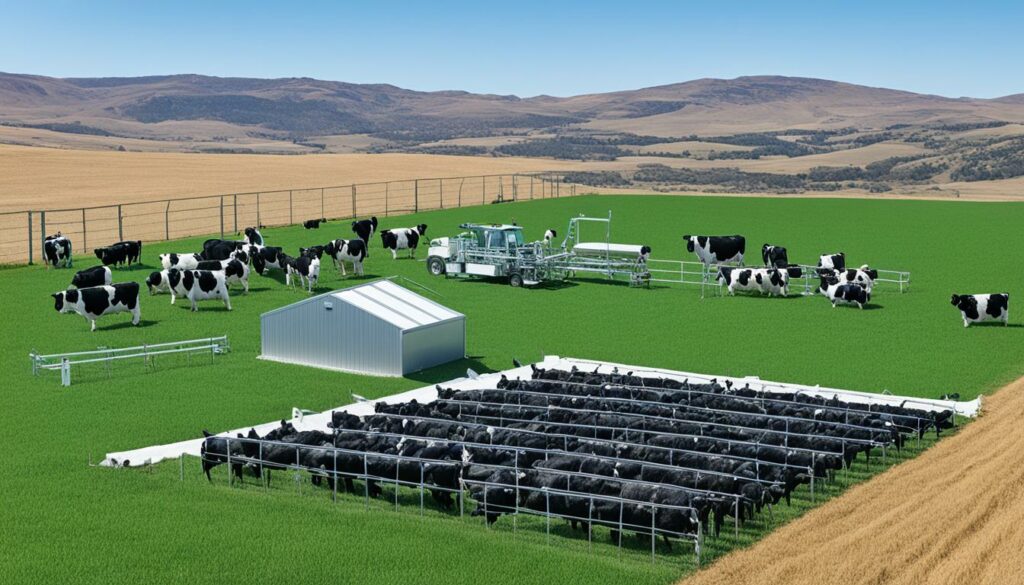
We’re seeing more focus on keeping track of animals without touching them. Tools like behaviour-sensing algorithms are becoming key parts of farming. They help farmers know how each animal is doing, all the time.
This next step includes software that looks after feeding based on real-time data. It makes sure each animal gets the best food for them. Plus, it helps farmers really know their animals by tracking everything about them, from where they started to how they’re growing, making farm work more efficient.
Looking ahead, we expect to see more tools that help farmers make smart choices. These tools offer new ways to plan and manage resources with the best data. This not only cuts down on costs but also makes farms run smoother.
This future also means it will get easier to add these new tools to farms. Tailored solutions will fit any farm, making sure everyone can get a boost from these tech advancements. The focus on farming ingenuity is pushing the use of advanced tech, and this will lead to a better, more sustainable way to raise animals for the future.
Using livestock health analytics is crucial for today’s farms. But it faces several big hurdles. These include the costs, technical issues, and farmers being slow to change.
Livestock analytics face a big challenge in the cost to start. In the year 2023, the U.S. Department of Agriculture (USDA) found only 27% of U.S. farms used high tech farming practices. These include things like precision agriculture. Even with support from the USDA and the National Science Foundation (NSF), which gave almost $200 million during 2017 to 2021, money is still a problem. Farmers have to think about if the costs are worth the boost in crops and profit.
On top of costs, there’s the tech side to worry about too. Bringing in new systems might not work smoothly with old ones. The question of who owns and shares farm data is also a big deal. Plus, there’s no set way or tools that everyone uses in livestock health analytics. This makes it hard for all farms to use the tools in the same way.
Getting farm workers to use new technology isn’t easy. People are often scared of what’s new. But with the right help and training, farmers and their staff can learn to use new tech. It’s also key to show them the good things that can come from it. Things like more efficiency and being better for the planet. Making new policies that help with innovation and data management is also important.”
Livestock health monitoring is changing with new data-focused techniques. This makes *data security in farming* very important. We must protect this data carefully to avoid any misuse or loss.
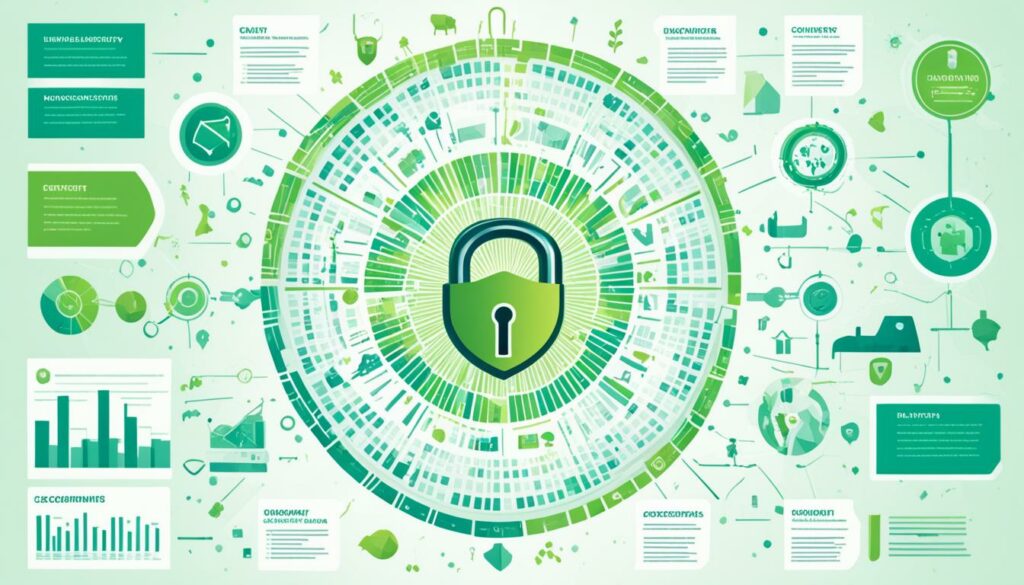
Sensors are at the heart of the livestock monitoring market, holding a 51 percent share. For instance, Allflex collects data from millions of cows all over the world. This data helps improve finances, animal well-being, and productivity.
The growth of IoT in farming means we need to keep all data safe. This field is set to reach USD 11.18 billion by 2029. Looking after every bit of data is crucial.
*Privacy issues in livestock monitoring* are a big concern. To protect private information, strict rules are needed. Companies might find it hard to share data because of traditional practices and a lack of technology.
It’s important to follow the rules and use strong *data protection solutions*. Showing how sharing data benefits everyone can encourage better cooperation. This could help create a safer and more responsible way of handling data in the industry.
As our world moves towards sustainability, using health analytics with livestock is key. It helps reduce antibiotic use. It also lessens the environmental harm from farming.
Livestock health analytics cuts antibiotic use significantly. It monitors health signs early to detect disease. This allows farmers to act before disease spreads, reducing the need for antibiotics.
Advanced techniques pinpoint the most crucial moments for health reactions. This approach improves animal care and lessens the risk of antibiotic resistance.
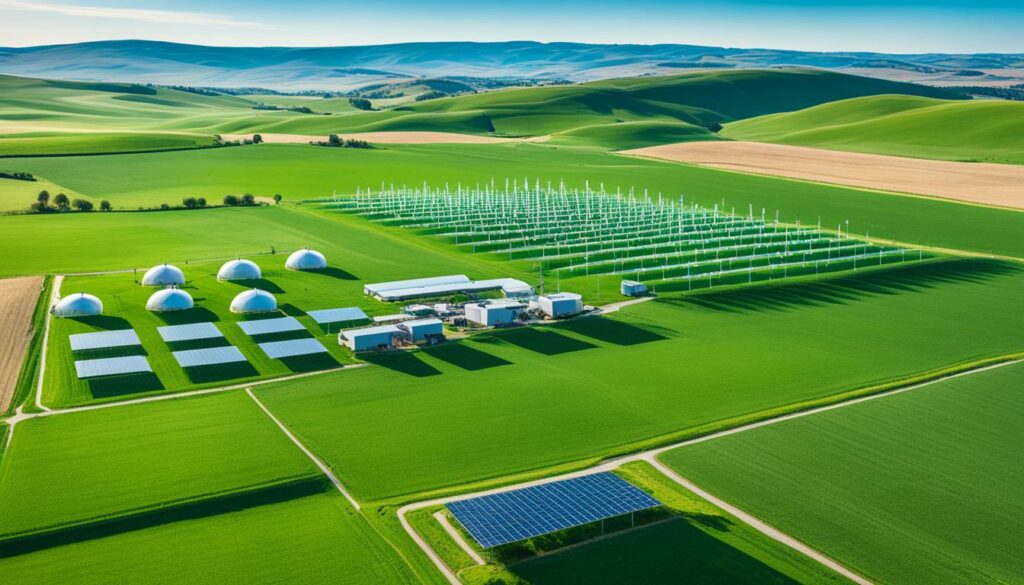
Using advanced health analytics also helps the environment. According to the FAO, following the best health and care practices cuts livestock emissions by up to 30%.
Better disease treatment in livestock reduces emissions too. A study in Scotland showed this could cut down emissions by 4.5%. Changing what animals eat, like adding specific fats, can also decrease methane by 14%.
And, a product or sunflower seeds can cut methane by 33%. This is good for the air we breathe.
“Scientists in New Zealand are even developing a vaccine to target methane-producing gut bacteria in dairy cows, potentially reducing methane emissions by up to 30%.”
Livestock health data helps farmers choose the best approaches for the environment. It supports both high production and less harmful farming. Livestock health analytics is vital for the future of farming.
| Projected Milestone | Details |
|---|---|
| Global Middle Class Growth by 2030 | Expected to reach five billion |
| Global Population by 2050 | Projected to reach 10 billion |
| Potential Reduction in Livestock Emissions | Up to 30% with best practices |
| Emission Savings from Improved Disease Treatment | 4.5% in cows and sheep |
| Methane Reduction with Diet Changes | 14% to 33% |
| Methane Reduction with 3-NOP Supplement | Up to 30% in dairy cows |
Introducing livestock health analytics to farming is a big step ahead for agriculture. These analytics bring many benefits. They allow farmers to keep up with what each animal needs in real time.
Knowing an animal’s health history from start to finish is crucial. It helps with planning and saves money. A lot of top researchers have worked hard to make these tools better.
The future with livestock health analytics looks bright. New tech, like improving an animal’s genes, can make them healthier or produce more. Also, using probiotics and prebiotics in feed makes them stronger against sickness.
As we use more data in caring for animals, the whole livestock business improves. Our aim is to produce better goods more quickly. This approach also helps the environment by cutting down waste.
Taking on these new technologies is a key move. It not only helps our farms do better but also supports the planet. These advances in farming tell us one thing: they make our future brighter and more sustainable.
Livestock health analytics uses data to keep animals healthy and productive. It looks at health from a digital angle. By using data tools, farmers can track and improve on how they look after their livestock.
It helps farmers quickly spot any issues in their animals. This means the animals stay healthy and farms run better. It’s good for the environment too as it reduces the need for antibiotics.
It makes farms more efficient by finding risks and inefficiencies. By catching diseases early, it cuts down on costs and antibiotic use. This also means animals are treated better.
Tools like wearable sensors and software are at the heart of health monitoring. For example, sensors on animals and apps that collect this data. They show a lot about an animal’s health and behaviour.
It starts with picking the right tools and setting them up. It’s important to train the farmer to use these tools. This way, the farm can get healthier and more productive.
Wearable sensors constantly watch over the animals’ health. They feed back data in real time. This helps farmers keep their livestock in tip-top shape.
It’s about keeping an eye on how animals grow and what they eat. This data helps farmers feed their animals better and use food more wisely. Efficient food use means farms run better.
It uses data to find diseases early. By setting thresholds and using analytics, diseases can be spotted fast. This helps prevent and control illnesses, making farms safer.
Looking for disease signs, tracking growth, and checking what animals eat are vital. These give clear facts on animal health. With this information, farmers can make good, custom choices for their farm.
Stories of smaller and bigger farms show the strength of using health analytics. They prove it boosts output and keeps animals well in all kinds of farms. It shows how using data smartly can change farming for the better.
New ways to watch health without touching animals and smart algorithms are leading the way. These advances will make farming cleaner and more effective. They’re changing how we look after farm animals.
Getting past tech issues, money worries, and changing how farms work can be tough. To overcome these, farms need a detailed plan, support, and training. This ensures new data tools boost the farm without causing hardships.
Keeping data safe and private is about using the right tech and following rules. This stops data from being misused or shared. It’s about using data for good while keeping farmers and animals safe.
It helps farms use less antibiotics and be greener. By focusing on staying ahead of diseases, farms can be kinder to the planet. This ensures a healthy balance between farming needs and the environment.